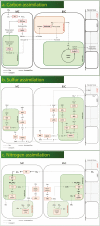Integration of sulfate assimilation with carbon and nitrogen metabolism in transition from C3 to C4 photosynthesis
- PMID: 31124557
- PMCID: PMC6698703
- DOI: 10.1093/jxb/erz250
Integration of sulfate assimilation with carbon and nitrogen metabolism in transition from C3 to C4 photosynthesis
Abstract
The first product of sulfate assimilation in plants, cysteine, is a proteinogenic amino acid and a source of reduced sulfur for plant metabolism. Cysteine synthesis is the convergence point of the three major pathways of primary metabolism: carbon, nitrate, and sulfate assimilation. Despite the importance of metabolic and genetic coordination of these three pathways for nutrient balance in plants, the molecular mechanisms underlying this coordination, and the sensors and signals, are far from being understood. This is even more apparent in C4 plants, where coordination of these pathways for cysteine synthesis includes the additional challenge of differential spatial localization. Here we review the coordination of sulfate, nitrate, and carbon assimilation, and show how they are altered in C4 plants. We then summarize current knowledge of the mechanisms of coordination of these pathways. Finally, we identify urgent questions to be addressed in order to understand the integration of sulfate assimilation with carbon and nitrogen metabolism particularly in C4 plants. We consider answering these questions to be a prerequisite for successful engineering of C4 photosynthesis into C3 crops to increase their efficiency.
Keywords: Flaveria; C4 photosynthesis; cysteine; evolution; primary metabolism; sulfate assimilation.
© The Author(s) 2019. Published by Oxford University Press on behalf of the Society for Experimental Biology.
Figures



Similar articles
-
Sulfate Metabolism in C4 Flaveria Species Is Controlled by the Root and Connected to Serine Biosynthesis.Plant Physiol. 2018 Oct;178(2):565-582. doi: 10.1104/pp.18.00520. Epub 2018 Aug 13. Plant Physiol. 2018. PMID: 30104256 Free PMC article.
-
Sulfate assimilation and glutathione synthesis in C4 plants.Photosynth Res. 2005 Dec;86(3):363-72. doi: 10.1007/s11120-005-3482-z. Epub 2005 Nov 12. Photosynth Res. 2005. PMID: 16307309 Review.
-
A critical review on the improvement of photosynthetic carbon assimilation in C3 plants using genetic engineering.Crit Rev Biotechnol. 2012 Mar;32(1):1-21. doi: 10.3109/07388551.2010.533119. Epub 2011 Jun 24. Crit Rev Biotechnol. 2012. PMID: 21699437 Review.
-
Uncovering C4-like photosynthesis in C3 vascular cells.J Exp Bot. 2018 Jun 27;69(15):3531-3540. doi: 10.1093/jxb/ery155. J Exp Bot. 2018. PMID: 29684188 Review.
-
Photorespiration and nitrate assimilation: a major intersection between plant carbon and nitrogen.Photosynth Res. 2015 Feb;123(2):117-28. doi: 10.1007/s11120-014-0056-y. Epub 2014 Nov 4. Photosynth Res. 2015. PMID: 25366830 Review.
Cited by
-
Target of Rapamycin Signaling in Plant Stress Responses.Plant Physiol. 2020 Apr;182(4):1613-1623. doi: 10.1104/pp.19.01214. Epub 2020 Jan 16. Plant Physiol. 2020. PMID: 31949028 Free PMC article. Review.
-
Cross-Talks Between Macro- and Micronutrient Uptake and Signaling in Plants.Front Plant Sci. 2021 Oct 15;12:663477. doi: 10.3389/fpls.2021.663477. eCollection 2021. Front Plant Sci. 2021. PMID: 34721446 Free PMC article. Review.
-
Physiological and Biochemical Responses, and Comparative Transcriptome Profiling of Two Angelica sinensis Cultivars Under Enhanced Ultraviolet-B Radiation.Front Plant Sci. 2021 Dec 17;12:805407. doi: 10.3389/fpls.2021.805407. eCollection 2021. Front Plant Sci. 2021. PMID: 34975996 Free PMC article.
-
Genetic encoding of complex traits.J Exp Bot. 2021 Jan 20;72(1):1-3. doi: 10.1093/jxb/eraa498. J Exp Bot. 2021. PMID: 33471904 Free PMC article. No abstract available.
-
Drought induced metabolic shifts and water loss mechanisms in canola: role of cysteine, phenylalanine and aspartic acid.Front Plant Sci. 2024 Dec 23;15:1385414. doi: 10.3389/fpls.2024.1385414. eCollection 2024. Front Plant Sci. 2024. PMID: 39781188 Free PMC article.
References
-
- Adwy W, Laxa M, Peterhansel C. 2015. A simple mechanism for the establishment of C2-specific gene expression in Brassicaceae. The Plant Journal 84, 1231–1238. - PubMed
-
- Aubry S, Smith-Unna RD, Boursnell CM, Kopriva S, Hibberd JM. 2014. Transcript residency on ribosomes reveals a key role for the Arabidopsis thaliana bundle sheath in sulfur and glucosinolate metabolism. The Plant Journal 78, 659–673. - PubMed
-
- Becker TW, Carrayol E, Hirel B. 2000. Glutamine synthetase and glutamate dehydrogenase isoforms in maize leaves: localization, relative proportion and their role in ammonium assimilation or nitrogen transport. Planta 211, 800–806. - PubMed
Publication types
MeSH terms
Substances
LinkOut - more resources
Full Text Sources
Miscellaneous

